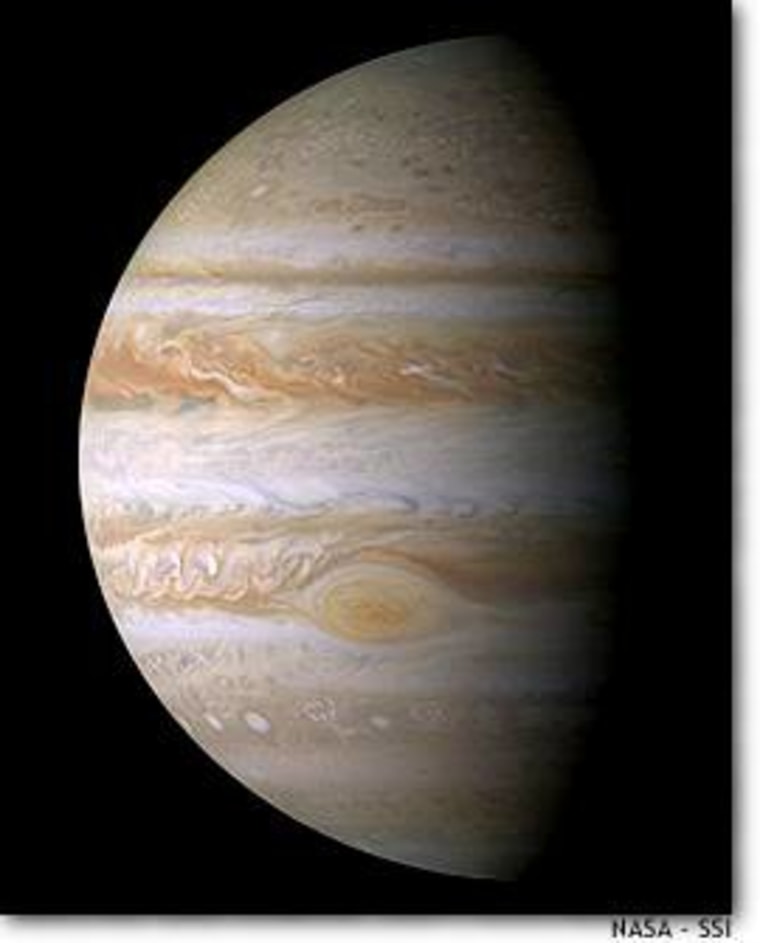When the Cassini spacecraft finally gets to Saturn next year, it will have some big shoes to fill — its own. The robotic probe has snapped what’s being billed as the best picture ever of Jupiter.
WHILE ASTRONOMERS eagerly await Cassini’s encore, expected to involve the most detailed exploration ever made of Saturn, mission managers are reveling in the new Jupiter photo, taken Dec. 29, 2000, and released Thursday.
“The imaging team wanted very much to take the ultimate picture of Jupiter,” said Carolyn Porco, Cassini imaging team leader at the Space Science Institute in Boulder, Colo. “The one that would show Jupiter in all its intricate and glorious complexity, the one that would knock your socks off.”
The mosaic photograph, involving 27 snapshots made with Cassini’s narrow-angle camera, was taken about a day before the craft’s closest approach to Jupiter. At the time, the NASA probe busy collecting other data, and scientists back home were busy analyzing it all.
“We managed to wedge this series of images in among all the pressing scientific observations going on near Cassini’s closest approach to Jupiter, and we’re very glad now that we did,” Porco said.
Porco and her colleagues said it is the most detailed global color view of Jupiter ever seen. It was taken from about 6.2 million miles (10 million kilometers) away.
REAL COLORS
The image reveals the planet’s colors close to what the human eye would see. Ashwin Vasavada, a Cassini imaging team associate and planetary scientist at the University of California at Los Angeles, put the mosaic together.
Data for the image were collected as the planet rotated, so stitching the images together was tricky.
After being put together, the new picture was reilluminated to show the planet as it would have appeared at the time of the first image but under different lighting conditions. Vasavada added more contrast to the final photo to enhance visibility of atmospheric features.
“Jupiter really is a planet of clouds,” Vasavada said in a statement. “You can stare for hours at the different forms, patterns and colors on this image. Bright, white thunderstorms punctuate several of Jupiter’s bands, while the Great Red Spot, a vortex big enough to swallow Earth, leaves a large, turbulent wake behind it. Jupiter shows us what an atmosphere is capable of on the grandest scale.”
Jupiter is 11 times wider than Earth and is almost all gas. Scientists do not know if it might have a small rocky core. Cloud bands and large spots persist on the gas giant for years. The Great Red Spot, a hurricanelike structure, has been raging for at least three centuries.
The Jovian clouds are made of ammonia, hydrogen sulfide and water, scientists say. Updrafts and downdrafts create different mixtures of these substances, leading to clouds at different heights. Bluish areas, such as the small features just north and south of the equator, are regions of reduced cloud cover, where one can see deeper into the almost endless atmosphere.
NEXT UP
Cassini will reach Saturn’s orbit on July 1, 2004. It will release its piggybacked Huygens probe about six months later for descent through the thick atmosphere of the moon Titan. During its orbit around Saturn, Cassini will be closer to that planet than it was to Jupiter when the newly released photograph was made.
“Our images taken in the Saturnian system should be absolutely spectacular,” said Robert Mitchell, Cassini project manager at NASA’s Jet Propulsion Laboratory.
The mission is a cooperative effort of NASA, the European Space Agency and the Italian Space Agency.
High-resolution versions of the image are available on the Web site of the Cassini Imaging Central Laboratory for Operations, or CICLOPS.
© 2003 Space.com. All rights reserved.
